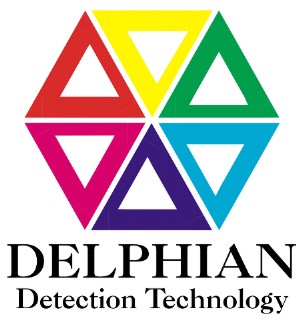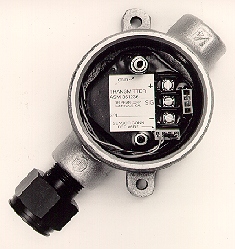Combustible Sensor Transmitters
Constant Temperature Operation Operating Circuits: When combustible hydrocarbons come into contact with a sensor, the exothermic chemical reaction at the catalyst adds chemical energy to the active bead. The reference bead causes no reaction and, therefore, gains no chemical energy. In constant voltage and constant current circuits, the reference and active beads are connected in series in a Wheatstone bridge. The increased energy from the catalytic reaction raises the active bead temperature, which in turn raises its resistance. This increase in the active bead resistance unbalances the bridge and provides a means of electrically measuring the hydrocarbon concentration. Delphian's patented Sensor Saver is a constant temperature circuit. It maintains both the reference and active beads at a constant temperature independent of any changes in ambient temperature and prevents the active bead from heating up in the presence of combustible gas. Sensor Saver circuitry continuously monitors the resistance of the reference and active elements and changes the electrical power to each bead to maintain the active bead at a constant resistance, and therefore, a constant temperature. The difference in power supplied to the reference and active beads provides the measurement signal. This technique provides a very linear method of measuring the concentration of combustible gas without the degradation which results from increased sensor temperature. Sensor Degradation: When two identical sensors, one operating in a constant voltage circuit, and one in a constant temperature circuit, were both subjected to methane exposure, sensor degradation of the constant voltage circuit was far more rapid because of the higher sensor temperatures it experienced. This degradation is irreversible; when the sensor temperature returns to normal, the sensitivity will not be restored. The same degradation problems exist in constant current circuits. Many alarms would not be seen in hazardous situations without the constant temperature circuit. A low ambient temperature can prevent alarms in constant voltage circuits. Performance After Degradation: Two irreversible changes occur during degradation, showing that the catalyst becomes less effective. First, the signal size decreases—this effect is countered by recalibration until the maximum sensitivity of the system is reached. Second, the parametric curves shift to the right, which reduces the margin between the temperature at which the catalyst becomes active and the sensor operating temperature. For a constant voltage or constant current circuit, this means that a smaller drop in ambient temperature could keep the sensor from turning on, resulting in no sensor response to any concentration of combustible gas. Thus, a sensor that performs properly during calibration on a normal day may be dead on a cold day. The same degraded sensor in a constant temperature circuit, on the other hand, continues to perform properly, never missing an alarm regardless of the ambient temperature. Summary: High sensor temperatures, whether because of combustible hydrocarbon exposure or ambient temperature, will accelerate sensor degradation. Low sensor temperature can reduce signal size and compounds the problems of a degraded sensor. The results of changing sensor temperatures are shorter sensor life and missed alarms. The Delphian Sensor Saver circuit offers the technically correct solution of maintaining the sensor at a constant temperature, thus extending the sensor life and eliminating this potential for missed alarms. Electrochemical Sensor Transmitters The signal current is sent to the system control device via a 3-wire cable. This current must be terminated so that the signal remains at least 15 volts below the transmitter "+" terminal when the signal is at the maximum 20 mA. A 250 ohm resistor which is connected from the control devices signal input to ground is the standard form of 4-20 mA termination. Adjustments in the control device should allow the conversion of the current signal from the transmitter into standard gas concentration values. These values can be displayed and used to activate alarms, when appropriate, by the control system. It should be noted that the Delphian analog controllers require a 1-5 mA signal.
Accessory
Modules When no accessory module is connected to the transmitter, the output current passes through the jumper on J2, to the SIG terminal and to the control device. If an accessory module is connected, then the jumper is removed and the current routed via a cable to the accessory module. The scaled output is routed back through the cable to J2, to the SIG terminal and then to the control device. By adjustment of the ZERO and SPAN controls on the remote calibration module, its output can be scaled. When the calibration meter is inserted into a unit outfitted with remote calibration, its relatively low impedance pulls the anode voltage of the blocking diode below that of the cathode. This allows measurement with the meter but prevents current from flowing back to the control device, thus avoiding alarms during calibration. Scaling of the signal output is accomplished by momentarily placing the zero and then the span ends of a calibration wand on the digital display from the outside of the conduit box. In addition to scaling the output, SafeCAL provides a digital readout of gas concentration and performs various checks to prevent common calibration errors. Sensor Extension Kit Sensor Extension Cord
Glossary
of Gas Detection Terms |
Part
Numbers Copyright ©2025 Delphian Corporation, 220 Pegasus Avenue, Northvale, N.J., U.S.A. |
|||||||||||


